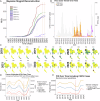Climate, inter-serotype competition and arboviral interactions shape dengue dynamics in Thailand
- PMID: 40216923
- PMCID: PMC11992266
- DOI: 10.1038/s42003-025-07999-9
Climate, inter-serotype competition and arboviral interactions shape dengue dynamics in Thailand
Abstract
The incidence and global spread of dengue are reaching alarming levels. Thailand represents a critical disease epicenter and demands an understanding of the environmental and evolutionary pressures that sustain DENV transmission. Unlike most affected countries experiencing recurrent outbreaks of the same serotype or replacement of one serotype for another, Thailand is an ecological niche for all four serotypes. Favorable climate and mosquito vector availability maintain a landscape defined by stable, endemic circulation of genotypes, with minimal genetic variation attributed to sporadic, external introductions. This equilibrium is achieved through inter-serotype competition, characterized by reproductive fitness levels that maintain infections (Re>1) and elevated evolutionary rates ( ~ 10-4), which steadily increase the genetic diversity of each serotype. This conclusion is reinforced by the identification of numerous positively selected mutations, skewed in the direction of non-structural proteins conferring replication and transmission advantages versus those present in structural proteins evading neutralizing antibodies. Precipitous drops in DENV cases following outbreaks of Chikungunya suggest that interactions with other arboviruses also impact DENV dynamics through vector competition, replication inhibition or partial cross-protection. Thailand is a major exporter of DENV cases and novel emergent lineages gaining fitness here are likely to spread internationally. Surveillance is therefore paramount to monitor diversification trends and take measures to avoid the establishment of similar sustained, local transmission in other countries.
© 2025. The Author(s).
Conflict of interest statement
Competing interests: Funding for this project was provided by Abbott Laboratories. The funder provided support in the form of salaries for authors L.J.P., J.Y. S.W., G.A.C., T.M. M.R. and M.G.B., and but did not have any additional role in the study design, data collection and analysis, decision to publish, or preparation of the manuscript.
Figures





Similar articles
-
Competitive advantage of a dengue 4 virus when co-infecting the mosquito Aedes aegypti with a dengue 1 virus.BMC Infect Dis. 2016 Jul 8;16:318. doi: 10.1186/s12879-016-1666-0. BMC Infect Dis. 2016. PMID: 27390932 Free PMC article.
-
The spatial and temporal scales of local dengue virus transmission in natural settings: a retrospective analysis.Parasit Vectors. 2018 Feb 2;11(1):79. doi: 10.1186/s13071-018-2662-6. Parasit Vectors. 2018. PMID: 29394906 Free PMC article.
-
Potential role of vector-mediated natural selection in dengue virus genotype/lineage replacements in two epidemiologically contrasted settings.Emerg Microbes Infect. 2021 Dec;10(1):1346-1357. doi: 10.1080/22221751.2021.1944789. Emerg Microbes Infect. 2021. PMID: 34139961 Free PMC article.
-
Evolution of dengue in Sri Lanka-changes in the virus, vector, and climate.Int J Infect Dis. 2014 Feb;19:6-12. doi: 10.1016/j.ijid.2013.10.012. Epub 2013 Dec 11. Int J Infect Dis. 2014. PMID: 24334026 Review.
-
Molecular evolution of dengue viruses: contributions of phylogenetics to understanding the history and epidemiology of the preeminent arboviral disease.Infect Genet Evol. 2009 Jul;9(4):523-40. doi: 10.1016/j.meegid.2009.02.003. Epub 2009 Feb 13. Infect Genet Evol. 2009. PMID: 19460319 Free PMC article. Review.
References
-
- Murugesan, A. & Manoharan, M. in Emerging and Reemerging Viral Pathogens (ed Moulay Mustapha Ennaji) 281–359 (Academic Press, 2020).
-
- Organization, W. W. H. Disease Outbreak News; Dengue – Global situation. (2023).
-
- Khan, M. B. et al. Dengue overview: An updated systemic review. J. Infect. Public Health16, 1625–1642 (2023). - PubMed
MeSH terms
LinkOut - more resources
Full Text Sources
Medical

